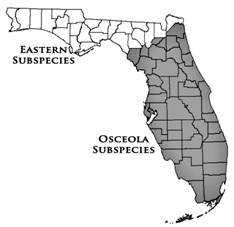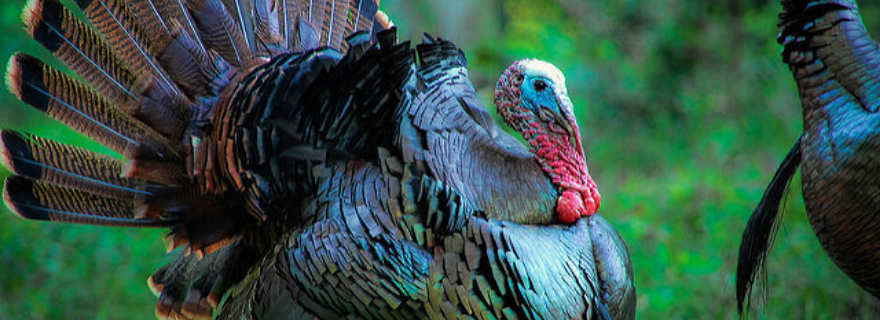As you think about roasting that giant, dome-shaped turkey for Thanksgiving dinner on Thursday, here is the “skinny” on Florida’s native turkeys – a distant relation to the bird the pilgrims ate, and even more distant from the farm-bred variety.

Florida is home to two of the five wild turkey subspecies in the United States, with the Osceola turkey (also known as the Florida wild species) found in peninsular Florida being the smallest of the five. While similar in appearance to the eastern subspecies that inhabits the rest of the eastern seaboard and northern Florida, the Osceola turkeys are usually smaller and darker in color.
The flight feathers of the wings have less white barring, with the white bars being narrower and irregular and black bars dominating their wing feathers. Osceola turkeys also have more iridescent green and red hints in the feathers than the eastern subspecies found in northern Florida and the east coast of the U.S. Those darker colors and longer legs of the Osceola turkey make them better adapted to survive in Florida’s varied habitats. While the differences between the Osceola Turkey and Eastern Turkey are subtle, the Osceola is one more animal that makes Florida a special place.


The Tampa Bay region played a crucial role in the subspecies designation with the Osceola being described in the late 1800s by W.E.D. Scott, using a museum specimen that had been collected in Tarpon Springs. Scott also documented the decimated wading bird populations brought about by plumage hunters in Tampa Bay and southern Florida.
A century ago, turkey populations across the country had crashed due to overhunting and habitat destruction, with many states completely losing their turkey populations. The Florida wild turkey may have been somewhat shielded from the country-wide population crash due to the inaccessibility of prime habitats, but the population still was highly impacted by habitat destruction and eliminated entirely from portions of the Everglades. Attempts to repopulate using captive-bred turkeys weren’t successful as they had low survival rates in the wild.
It wasn’t until the 1950s when cannon nets were found to be an effective method to capture large numbers of turkeys for relocation in South Carolina that the stage was set for the species to repopulate and thrive. While captive-bred turkeys were unable to adapt to life in the wild, relocating wild turkeys in suitable habitats around the country proved successful. By the 1970s, turkey populations in Florida rebounded due to the conservation efforts.
Check out a cannon net in action:
Want to learn more?
Read more about conservation efforts in Florida here.
FWC Wild Turkey Management Program
By H. Young, originally published Nov. 20, 2018
